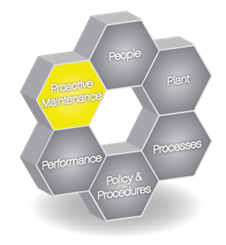“Ensuring our Assets are managed in the most cost effective manner”

Proactive maintenance is key to successful organizations’ long-term strategies for managing costs and equipment. Using modeling, analyses and audits in conjunction with proactive maintenance measures can ensure smoother operations, resulting in less downtime and money saved.
Proactive maintenance is usually reserved for those organizations who have worked their way up from being reactive and fire fighting. This journey is not an easy but is required to ensure that all assets are being balanced in terms of cost, performance and risk. This article is the 6th in the Plant Hexcellence™ series. We have previously discussed the People, Plant, Processes, Policy & Procedures and Performance cells within the Plant Hexcellence™ model and the corresponding supportive facets. We can now discuss Proactive Maintenance and the impact it has on enabling organizations to be truly cost effective in their maintenance programs.
The Need for Proactive Maintenance
I cannot remember where I heard it from, but I seem to remember that reactive maintenance costs at least 10x more that preventive maintenance. I also seem to remember a quote from a senior individual at Ford that indicated for every dollar spent on equipment design, there would ten dollars saved on maintenance and one hundred dollars saved on downtime.
These quotes go to show that being proactive in maintenance and reliability enables huge savings in the Cost of Goods Sold for any organization. But what really is Proactive Maintenance?
The Proactive Maintenance Facets
Like the previous cells covered, the Proactive Maintenance cell includes numerous facets, each representing a distinct and important part within a Proactive maintenance program. These facets can be grouped into different stages of the asset’s life cycle, emphasizing the need to consider the maintenance activities at all stages of the asset’s life to realize the full benefits. The facets include;
- RAM Modeling – can simulate the configuration, operation, failure, repair and maintenance of equipment. The inputs for a RAM model will include the physical components, equipment configuration and maintenance philosophy in a system and the outputs can determine average production of the system over it’s life.
- Weibull Analysis – are used to effectively determine both the pattern of failure that a specific component experiences for a specified failure mode. In addition to identifying the failure pattern it also provides an accurate assessment of the characteristic life of the component for the same failure mode.
- Assessment / Audit – ensures that the maintenance program is being carried out as planned and to a consistent and repeatable result. Often times, the maintenance routines are not executed in a way that ensures a consistent result and as such many potential failures go by unnoticed.
- Precision Maintenance – means to work to a set tolerance to ensure asset performance and trouble free operation. The tighter the tolerance the better the result. Precision maintenance includes machinery acceptance standards, precision balancing, alignment of shafts, chains or belts, base flatness standards, the removal of machine stresses, etc. Most importantly it’s commissioning to a standard and documenting the process.
- Preventive Maintenance – The care and servicing by personnel for the purpose of maintaining equipment in satisfactory operating condition by providing for systematic inspection, detection, and correction of incipient failures either before they occur or before they develop into major defects.
- Predictive Maintenance – Predictive maintenance (PdM) techniques are designed to help determine the condition of in-service equipment in order to predict when maintenance should be performed.
There are many different techniques and activities behind each of the facets. For example, RAM Modeling requires the equipment design and understanding / testing different combination of components to arrive at the best possible outcome. Once a RAM model has been established, then a Life Cycle Cost model can be built to determine the ROI for the different potential designs. Regardless, a holistic proactive maintenance program encompasses the facets above with all of their underlying activities.
Predictive Maintenance
Being able to accurately understand how an asset is performing and the remaining useful life is critical to making repair/replace/refurbishment decisions and coordinating equipment outages. There are a variety of tools, techniques and technologies which can be used in predictive maintenance. Some of the most common are;
- Visual Inspection – is a common method of quality control, data acquisition, and data analysis. Visual Inspection, used in maintenance of assets, means inspection of equipment and structures using either or all of raw human senses such as vision, hearing, touch and smell and/or any non-specialized inspection equipment.
- Vibration – is used to detect faults in rotating equipment (Fans, Motors, Pumps, and Gearboxes etc.) such as Unbalance, Misalignment, rolling element bearing faults and resonance conditions. Vibration analysis looks at the Displacement, Velocity and Acceleration of a component.
- Thermography – Infrared thermography (IRT), thermal imaging, and thermal video are examples of Thermography. Thermographic cameras usually detect radiation in the long-infrared range of the electromagnetic spectrum and produce images showing the differences in temperature.
- Tribology – Tribology is the science and engineering of interacting surfaces in relative motion. It includes the study and application of the principles of friction, lubrication and wear.
- Ultrasound – has a wide variety of uses and applications for detecting failure modes on mechanical, electrical and stationary equipment. It is based on the ability to hear F.I.T or Friction, Impact and Turbulence of the assets or fluids within it.
- Motor Current Analysis – is simply the process by which motor current readings are recorded and analyzed in the frequency domain. It has been around since 1985 and proven itself well over the years in locating rotor faults and air gap problems in motors.
There are many more technologies & methods available, and selecting the right technology for the application is critical. If you are not sure of what technology will be the best for a particular application (e.g. vibration or ultrasound for a large slow moving bearing), make sure to reach out to the experts.
Summary
Moving to a Proactive Maintenance environment is something that must be considered in the earliest stages of the asset life cycle and involves much more than just Predictive Maintenance. It requires careful thought and design of the asset, the proper installation of the asset and then conducting the right maintenance at the right time. In the event that you are unable to address the equipment design, you can still move to more of Proactive Maintenance environment by ensuring the assets are installed and maintained correctly, and defect elimination is taking place.
How have you worked towards an more proactive maintenance environment lately? What barriers are you encountering? I would highly encourage you to share your story so that others may learn or be inspired by it.
The Plant Hexcellence Model is a proven model that was developed by Scott Kelley at Geometric Reliability but is the model of choice for Eruditio, LLC. If you are interested in the Plant Hexcellence model for your site or organization, please contact [email protected].
Remember, to find success; you must first solve the problem, then achieve the implementation of the solution, and finally sustain winning results.
I’m James Kovacevic
Eruditio, LLC
Where Education Meets Application
Follow @EruditioLLC
References;

